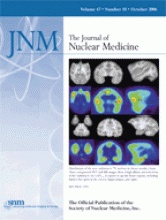Abstract
The response to cardiac resynchronization therapy (CRT) varies significantly among individuals. Preliminary data suggest that the presence of myocardial viability may be important for response to CRT. The aim of this study was to evaluate whether the extent of viability could predict response to CRT after 6 mo. Methods: Sixty-one consecutive patients with advanced heart failure, left ventricular ejection fraction < 35%, QRS duration > 120 ms, and chronic coronary artery disease were included. To determine the extent of viability all patients underwent nuclear imaging with 18F-FDG SPECT before implantation. Clinical and echocardiographic parameters were assessed at baseline and after 6 mo of follow-up. Results: The presence of myocardial viability was directly related to an increase in left ventricular ejection fraction after 6 mo of CRT. Furthermore, the extent of viability in responders (n = 38) was significantly larger compared with that of nonresponders (n = 23; 12 ± 3 vs. 7 ± 3 viable segments, P < 0.01). Moreover, the optimal cutoff value to predict clinical response to CRT was identified at an extent of 11 viable segments or more (in a 17-segment model), yielding a sensitivity of 74% and a specificity of 87%. Conclusion: The presence of myocardial viability is directly related to response to CRT in patients with ischemic heart failure. Interestingly, using a cutoff level of 11 viable segments or more, the extent of viability could be used to predict response. Therefore, evaluation for myocardial viability may be considered in the selection process for CRT.
Footnotes
-
COPYRIGHT © 2006 by the Society of Nuclear Medicine, Inc.







